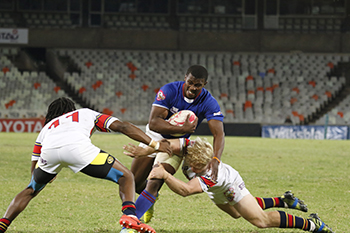Latest News Archive
Please select Category, Year, and then Month to display items
05 June 2018
Photo Supplied
 Archaeological excavations in the Wonderwerk Cave, north of Kuruman in the Northern Cape.
Archaeological excavations in the Wonderwerk Cave, north of Kuruman in the Northern Cape.
Research fellow Dr Lloyd Rossouw from the Department of Plant Sciences at the University of the Free State (UFS) recently published an article in the Nature Ecology and Evolution journal with Dr Michaela Ecker from the University of Toronto as lead author, and Dr James Brink, research fellow at the UFS Centre for Environmental Management. The findings described in “The palaeoecological context of the Oldowan-Acheulean in southern Africa” provides the first extensive paleoenvironmental sequence for the interior of southern Africa by applying a combination of methods for environmental reconstruction at Wonderwerk Cave, which have yielded multiple evidence of early human occupation dating back almost two million years ago.
Where water once was
The Wonderwerk Cave is found north of the Kuruman hills (situated in Northern Cape) a 140m long tube with a low ceiling. The surroundings are harsh. Semi-arid conditions allow for the survival of only hardy bushes, trees, and grasses. But during the Early Pleistocene, stepping out of the Wonderwerk Cave you would have been greeted by a completely different site, the researchers found. Using carbon and oxygen stable isotope analysis on the teeth of herbivores (Dr Ecker), fossil faunal abundance (Dr Brink), as well as the analysis of microscopic plant silica remains (phytoliths) excavated from fossil soils inside the cave (Dr Rossouw), the results show that ancient environments in the central interior of southern Africa were significantly wetter and housed a plant community unlike any other in the modern African savanna.
What difference does it make?
While East African research shows increasing aridity and the spread of summer-rainfall grasslands more than a million years ago, the results from this study indicate an interesting twist. During the same period, shifts in rainfall seasonality allowed for alternating summer and winter-rainfall grass occurrences coupled with prolonged wetlands, that remained major components of Early Pleistocene (more or less the period between one and two million years ago) environments in the central interior of southern Africa. That means our human ancestors were also living and evolving in environments other than the generally accepted open, arid grassland model.
Young Shimla team reach Varsity Cup semi-final
2017-03-29

The Shimlas will be hoping that some of their stars,
like the brilliant flanker Phumzile Maqondwana, will be
on form in the 2017 Varsity Cup semi-final against
Tuks in Pretoria.
Photo: Johan Roux
The pressure in the Varsity Cup semi-final is on Tuks, which will be reason enough for Shimlas to play with freedom.
This is according to Jaco Swanepoel, Shimla assistant coach, on the big challenge awaiting his young rugby team in Pretoria on 3 April 2017. He says because Tuks are the favourites, it could be to the advantage of the visitors. Maties and the University of Johannesburg are playing in the other semi-final in Stellenbosch on the same day.
Tuks did Shimlas a favour
Tuks’ victory of 43-28 over the Pukke in Potchefstroom on 27 March 2017 helped the Shimlas, who had a bye, to end fourth on the log with 23 league points.
Shimlas had to make use of several new players this year, and few experts would have given them a chance of reaching the semi-finals. Swanepoel says although they are proud of this achievement, only a place among the top four was never their end-goal.
Good to be the underdog
The Shimlas lost their league match against Tuks in Bloemfontein with 19-65. This, as well as the fact that Tuks was at the top of the log with 34 league points, underlines the huge task ahead.
“The previous result (against Tuks) is encouragement for the players to show: We aren’t that much worse than Tuks,” says Swanepoel. “Perhaps it is good to be the underdog. We actually have no pressure on us and I hope the players feel the same way.”
Three teams in knockout matches
All three Varsity Cup teams from the University of the Free State (UFS) reached the knockout matches. Apart from Shimlas, the UFS Young Guns played against Tuks in a semi-final in Bloemfontein on 27 March 2017, but lost by 21-45. On 17 April 2017, Vishuis will meet the Puk’s Patria in the residence finals.